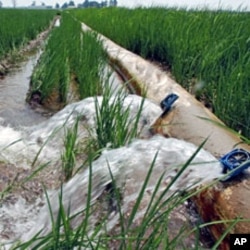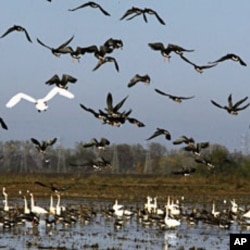Rice feeds more than half of the world’s eight billion people. It thrives in flooded areas and grows where other crops cannot survive. But paddy rice consumes more water than any other crop. And as drought conditions persist in parts of the world and water resources dwindle, rice experts are increasingly looking for ways to conserve water while meeting global demand.
Irrigated rice uses up to 39 percent of global water withdrawals for irrigation. Bas Bouman, Head of the Crop and Environmental Sciences Division at the International Rice Research Institute (IRRI) in the Philippines, said rice needs a lot of water because much of the water is lost from the field through seepage, percolation, and evaporation.
In California, where farming is more of a science, Agronomist Cass Mutters with the University of California said “water that’s applied, if it is not used by a crop, will have two ultimate destinations or fates, if you will. One is it either percolates deep into the soil and back into the groundwater, or it runs off into surface water,” Mutters explained.
But “traditional production of 1 kilogram of rice depletes about 4,500 kilograms of water,” said Bharat Sharma, Principal Researcher and Head of the New Delhi office of the International Water Management Institute in an email interview. The numbers are higher where irrigationsystems are inefficient.
Population growth and rising demand have increased pressure on agriculture and water resources. According to a NASA study of global groundwater, some of the world’s over-exploited areas are in northwest India. “These are also the regions which are highly critical for ensuring the food security of the country, as they produce surplus grains to meet the food deficit of several other regions,” said Sharma.
Some governments have mandated that farmers switch to other crops, which take less water per kilogram of output, said Janet Larsen, Director of Research at the Earth Policy Institute in Washington. She cited Egypt as an example of a country that has cut back on rice production, largely because of water use. “But I think the ultimate goal for researchers out there is doing conventional breeding, figuring out how … to get more crop per drop of water.”
Edward John Sadler of the U.S. Department of Agriculture (USDA) agreed that wheat and crops that do not grow in flooded areas have a potential to produce food with less water. But he suggested that a “cultural adherence to rice” in some regions makes switching unlikely.
More crop per drop
USDA engineers have been researching ways to use less water while growing rice, such as running a pipe through the fields. In parts of the U.S. like the lower Mississippi River Valley, Sadler said the practice is to place the water supply at the top paddy and then let the water cascade to the lower fields once the top paddy is flooded.
“What they did is they put the pipe in place and filled each paddy at the same time – all the paddies at once from that downslope poly pipe. And that allowed them to predict the completion time better,” said Sadler. “In the U.S., fields are not always right next to the farm. They’re scattered over 50-60 kilometers. And therefore, somebody has to run around and check.”
Sadler said adding the pipe saved about 20-25 percent of the water used in the process. And placing monitoring equipment to remotely report water levels or using sprinklers to irrigate rice can help control water flow as well.
“Farmers can also adopt a water-saving technology called Alternate Wetting and Drying [AWD], in which they let their fields fall dry for a number of days before re-irrigating them,” said IRRI’s Bouman. “If applied correctly, AWD can maintain yields with 15-30 percent of water savings.”
In regions where water is scarce, the system of Aerobic Rice, in which rice is grown without ponded water and saturated soil, uses 50 percent less water and produces 20-30 percent less yield. But Bouman said this new technology still needs more research and development.
And new varieties like short-season rice significantly reduce water use. Rice produced 40-45 years ago required 160 days from seed to harvest, compared to 135 days for short-season varieties. That, according to Mutters, has reduced the amount of water for rice production by about 20 percent over the last 30 years.
Pioneered by China, hybrid rice - a cross-bred robust variety - has increased land and yield productivity while reducing water use. According to Agricultural Economist Eric Wailes of the University of Arkansas, a Chinese paddy field yields about 4,355 kilograms of milled rice, or table rice. “And if we look at then how many liters does it take to produce 1 kilogram of rice in China? You know, that’s approximately about 1,750 liters of water to produce 1 kilogram of rice.”
In contrast, Wailes said India, which is on the verge of adopting hybrid rice, produces about 2,211 kilograms of rice per hectare. “And so, how much water does [it] take to produce a kilogram in India? Well, it takes about 3,500 liters – 3,500 liters in India, compared to only 1,750 [in China,]” said Wailes.
Genetic modification, according to Wails, could coax another 30-40 percent improvement in water efficiency per kilogram of rice. “In other words, instead of 1,750, I think you can get that probably down to 1,000 liters per kilogram. And that’s kind of at the levels that our other major crops grains are using,” he said.
But in Bouman’s view, genetic modification is unlikely to have a big role in reducing irrigation demands because much of the water used in rice fields is lost to seepage, percolation, and evaporation.
Good land management and technology
But good land management, such as keeping the soil compact and level, and building channels and dikes, can make water use more efficient. Nicole Van Vleck, a rice farmer and manager of Montna Farms in Yuba City, California, said all of the fields are laser-leveled.
“We use what’s called a drag scraper, which is outfitted with GPS [i.e., Global Positioning System] on it,” Van Vleck said. “And so we can maintain level fields each and every year. And this really helps water efficiency on an annual basis.”
Half of the water drained from Van Vleck’s farm goes into neighboring wetlands. She said 60 percent of the food consumed by wintering water fowl in the Pacific flyway comes from rice fields. “I have a field that’s covered sometimes with … hundreds and hundreds of birds - sometimes thousands of birds,” she said, describing the view from her office window.
In urban areas of the Philippines, Indonesia and Japan, rice paddies act as flood buffers holding water and capturing rainfall. And saline ocean water that seeps into the ground along coastal areas in places like Egypt “is offset by having rice fields, which again, have fresh water sit on top of [them] and push that salinization back down,” said Wailes.
Despite rice’s obvious functionality, Bouman said “there is no single silver bullet” to help rice farmers conserve water. “We do have an array of solutions, and it will be highly site-specific where which solution is most appropriate.”









